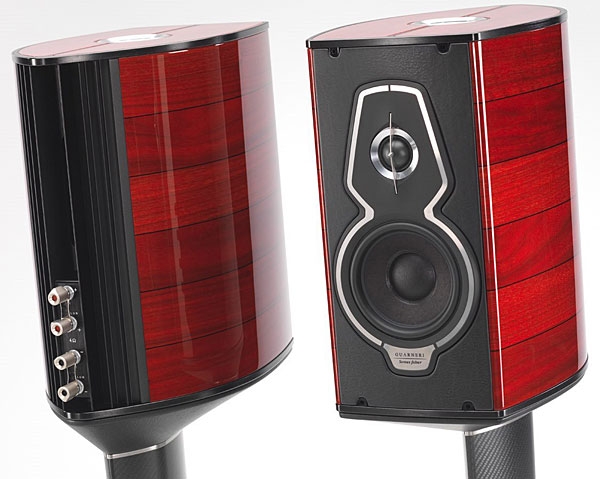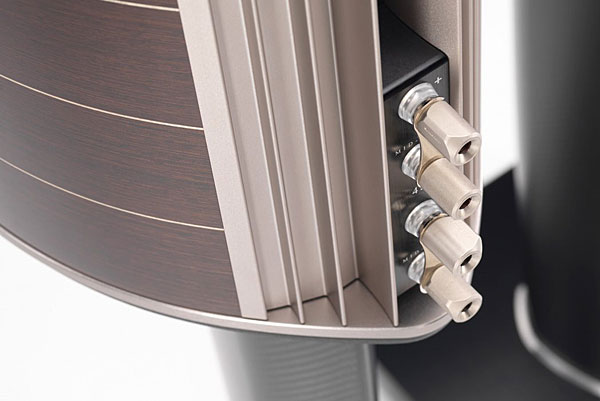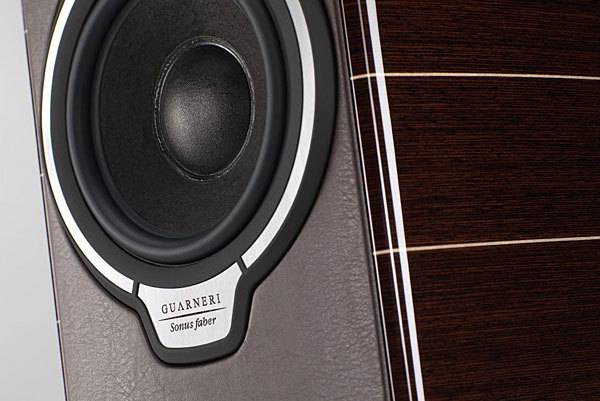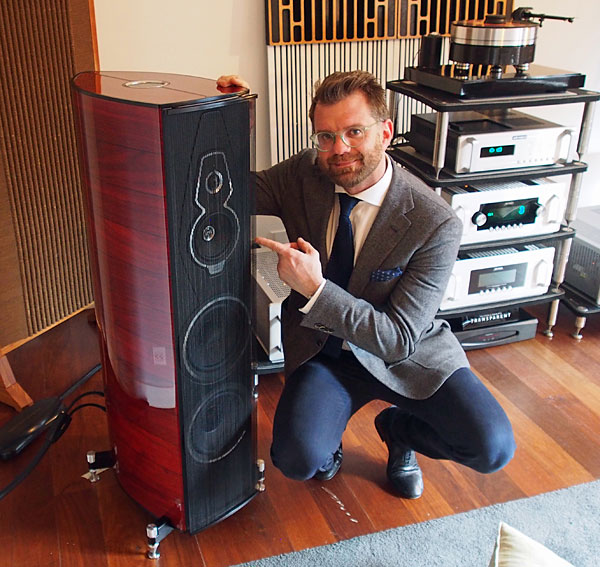| Columns Retired Columns & Blogs |
... KEF Reference 5 seems well worth it.
https://www.stereophile.com/content/kef-reference-5-loudspeaker
Or, you could go with the Reference 1 at half the price.

Sonus Faber launched their series of Homage Tradition loudspeakers at an event in February 2017, at the World of McIntosh Townhouse in Manhattan's NoHo neighborhood. After a presentation of the technology embodied in the new speakers, we listened to the line's three models, the floorstanding Amati and Serafino and the stand-mounted Guarneri, each in a dedicated room with a system based on Audio Research components. All three were sonically promising, but it was the smallest and least expensive that I felt would work best in my room. I asked for a pair for review.

Design
Every iteration of the Guarneri since the Homage has featured an elegantly lute-shaped cross section. The form is intended to pay homage to the famed 18th-century Italian violin makers—including, of course, the Guarneri family, of whom Giuseppe "del Gesó" Guarneri (1698–1744) was the final member practicing the craft. The curved sidewalls, laminated from several thin sheets of tonewood, are veneered with wengè (a tropical hardwood often used in guitar making), with maple horizontal inlays—or walnut stained red with black inlays—and attached to an MDF frame. The top and bottom panels are of brushed, titanium-colored aluminum; the bottom is finished with black felt where it couples to the stands, and the top has wooden inlays to match the sidewalls, with a central glass circle silk-screened with an Sf logo. With a front baffle finished in leather stained brown or black, and Sonus Faber's traditional grille of stretched vertical threads, the Guarneri Tradition is a stunningly beautiful piece of furniture.
But this is Stereophile, not Better Homes & Gardens; it behooves me to examine the technology used in this speaker. The tweeter and woofer are mounted vertically in-line within a vaguely violin-shaped accent of what looks like hard rubber, this outlined with aluminum. As in the tweeter used in the Guarneri Evolution, the Tradition's 1.1" (28mm) dome is of silk. But unlike the earlier speaker, a tiny damping pad is held against the center of the dome by a vertical bracket. This technology, which Sonus Faber calls Arrow Point or Damped Apex Dome (DAD), was first seen in their Lilium and Il Cremonese models, and is intended to optimize top-octave dispersion compared with ring-radiator tweeters and conventional domes. The tweeter is mounted in an acoustic-labyrinth chamber of wood.

The 5.9" (150mm) woofer features a sandwich cone and a neodymium magnet system, and is acoustically loaded with what SF calls its Stealth Ultraflex System. A vertically oriented, rectangular vent, radiused and lined with rubber at its top and bottom, is positioned between the flared vertical vanes on the aluminum rear panel. This port is 5" deep and its internal opening is damped with black foam, to control the speed of the air flowing through the duct and reduce its turbulence.
The two drive-units are crossed over at 2.5kHz with Sonus Faber's Paracross topology. At the World of McIntosh event, Paolo Tezzon, SF's manager of R&D, described this topology as producing "transparency, speed, and absolute musicality." In the diagram he showed, Paracross differs from a conventional CLC, third-order crossover in moving the second series capacitor to the other side of the drive-unit, so that that cap shares the ground connection with the shunt inductor. I don't see why there should be any electrical difference, but the proof of the concept, of course, will be in the listening. Electrical connection is via two pairs of binding posts mounted below the reflex port.

The Guarneri Tradition stands visually match the speakers and combine a carbon-fiber central pillar, filled with some kind of damping material, with aluminum top and bottom plates. Three guide pins on the top plate fit into dimples in the speaker's aluminum base for a secure stance. The massive bottom plate is fitted with four of Sonus Faber's Silent Spikes, which comprise a coaxial sandwich of metal, elastomer, and metal that has been patented by SF as Zero Vibration Transmission (Z.V.T.) and was first seen in their flagship Aida speaker.
We don't always comment on packaging, but the way these speakers and their stands were shipped deserves recognition. If someone is going to spend the price of a Toyota Corolla on an audio component, the manufacturer should ensure that every part of the experience is first-class, including the unpacking.
Sound Quality
After some experimentation, I positioned the Guarneri Traditions close to where the TAD Micro Evolution Ones had been when I listened to them for the review published elsewhere in this issue: with their woofers 74" from the wall behind them, and, due to my room's slight asymmetry, the left speaker's woofer 27" from the LPs lining the nearest wall, the right speaker's 42" from the books lining that wall. These positions slightly shelved down the low frequencies but gave the best transition between the mid- and upper-bass regions. The kick drum at the beginning of a live 2010 recording of Phish playing Little Feat's "Time Loves a Hero" (16-bit/44.1kHz FLAC, no longer available) was both well defined and had sufficient, er . . . kick.

... KEF Reference 5 seems well worth it.
https://www.stereophile.com/content/kef-reference-5-loudspeaker
Or, you could go with the Reference 1 at half the price.

The KEF house sound is not as warm as SF's. At least from what I remember from an audition of LS50s. But much much pricier...

And I would venture to suggest they got the ideas for the metal/leather/two contrasting woods from the inside of a mid-range Mercedes :-)

This audio jewelry that measures like Q-Acoustics (in every area!) has moved beyond cliche years ago. This goes for the big names too >>---> MTM's with passive subs underneath with price tags that do nothing but serve to make the buyers look uninformed. And a publication that looks as if it speaks for science yet only speaks for those that think spending more equals getting something that is actually better.
The reality is, the majority of "high-end audio" has been made obsolete (performance wise) years ago. To substantiate what I am saying, take for example the speakers that Michael Fremer uses now. They are nothing more than MTM's (Midwoofer, Tweeter, Midwoofer) with large, passive subs underneath. Compare these measurement wise to a pair of Q-Acoustics 3050's at ~$1000 pair and high-pass them to a 2 pairs of SVS subs at $4k a pair total price ~$5000. Regarding bandwidth, frequency response, distortion and ultimate loudness the Q-Acoustics/SVS system will equal if not surpass the performance of the aforementioned system. As a result, I see no reason why blind listening involving a lay audience would only confirm it.
And if that fails, lets kick it up a notch. Replace the Q-Acoustics with a pair of Troels Gravesen designed, and actively high passed, SB acoustics Satori MTM's for the same total price (the drivers where designed by the same Engineering Team that designed the Scanspeak drivers that Wilson uses for Christ sakes).
Then play fare.
"To the simple, everything appears simple"
P.S. I'm aware of the many factors involved regarding sound quality and loudspeaker design and their SQ is not limited to distortion and frequency response. Indeed, diffraction, acoustic phase, spectral decay and box panel resonance constitute what are important roles in the end game and the above designs listed perform as good any in these areas.

There are great monitors around for half that can compete with these beauties, The Focal Diablo comes to mind, gorgeous construction and great sounding speakers. Ortofan above is right, same money buys you full sized speakers that will go deeper. Still love monitors and these are beauts to consider if I had the coin.

I believe you mean the Focal Sopra 1. The Sopra 1 is about half the price of the SF Guarneri. The Diablo Utopia is in between both the Sopra and SFG in price.

But was thinking in terms British Pounds hence my mistaken comment on half price. You are correct the Diablo Utopia's are closer in USD to the Sonus Faber's. A better comparison would have been Totem's Mani-2 which for the price are stellar speakers and I think might even be less than half. I can even mention the DeVore monitors that I have heard and liked, don't know their name or price.

My first experience of Sonus Faber involved a mesmerizing audition of the Electa Amator II back in 1990/1991. Have always respected Sonus Faber since.
I wonder though, how much better can the Guaneri Tradition be at double the price of my Pulsars? The Pulsars are six years old, and they remain utterly captivating. To my eyes they also look just as good, and I never feel deprived listening to them.
To each according to her taste, I suppose. Interesting that at "$15,900/pair, including stands," the Guarneri Tradition is priced similarly to the Wilson Audio Sabrina. I've heard the Sabrina and it is a truly remarkable loudspeaker, also beautifully made and would occupy much the same floor space as the Guaneri.
My best wishes and sympathies to those trying to sort through such comparisons and tradeoffs. I'm so grateful that the Pulsars helped me to exit the upgrade merry-go-round.

Love the Joseph Audio monitors as well, heard them many times and always impressed. Jeff Joseph is a great guy too.

... Is available, just not on Tidal (presumably due to licensing issues), since they cover the entire "Waiting For Columbus" album as the second set of a three-set show... Here's a link for those interested, and I urge you to listen... I'm a fan of the original, but I was at this show, and it was a special performance. http://www.livephish.com/browse/music/0,575/Phish-mp3-flac-download-10-31-2010-Boardwalk-Hall-Atlantic-City-NJ

I'm surprised John did not mention another Stereophile review of a Sonus Faber stand-mounted, two-way speaker, the Concerto:
http://www.technologyfactory.com/reviews/SonusFaber/concerto_stereophile.pdf
The Concerto was definitely more affordable and put a Sonus Faber speaker in the range of those of us whose budgets have more real world limits. Thanks to that review --and others, I recall another rave in Jazz Times -- I purchased those speakers and their stands. They remain my primary speakers today and I have never regretted the purchase.

As mentioned by JA, I find the delayed energy @ 2KHz, as revealed by the waterfall plot, as a not very nice feature.
A speaker at this price point should not have design errors like this.

Seductive by all accounts, but I'd note in passing that here is yet another pair of speakers being tested a full six feet out into the room for best SQ. Designers are living in a different world from most of us.